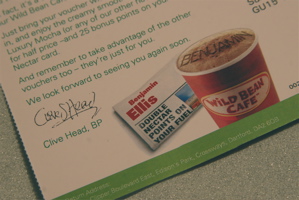Are You Paying Attention?
As we are supposedly living in an attention economy (amongst other things), and I am reading a few books on perceptual psychology, it seemed like a good idea to do a quick blog post about attention. I say seemed like a good idea… I got distracted! That’s the problem with all of these things competing for our attention…
But what is attention? Start by thinking of two book ends. On one side are our senses, on the other is our perception of what is going on. Think of your senses for a minute: Seeing, hearing, smelling, tasting and touching. Thankfully we haven’t entered the era of smellivision yet, so let’s focus on sight and sound.
There are different theories about how we perceive what we see and hear. Some theories say we shape what we sense to fit our knowledge (experience, biases, expectations and the like). Other theories say we perceive the world more directly. Still others say that we perceive ‘wholeness’ – even if there isn’t quite a ‘whole’ to be perceived, we join up the dots (see “understanding the reality of the situation“).
One thing is for sure, we don’t take everything in. Can you remember the time you arrived at work with absolutely no idea how you got there? Don’t worry, it isn’t that unusual. You were still using your senses (notice you didn’t drive into something or fall off of the train station), you just weren’t paying attention.
We can’t take in everything that goes off – our brains are big, but not that big. We have to apply some filters to the information our senses supply us with, to avoid getting overwhelmed. Again, there are different theories about how this filtering might work. It may be early or late in the scheme of things, but it does happen. We ignore most of the things that go off. Of course, you might argue that some people do this more than others!
This is where attention comes in to play, and why there is a whole industry trying to grab it. Attention controls how we apply the limited mental resources we have. There are two forces at work on your attention. On one side is the concious effort to attend to things – paying attention to what someone is saying or to what we are reading. On the other side, there are unconscious processes that direct our attention. These forces are just as relevant to social media and technology as they are to anything else we do.
If we want to read something, understand it and remember it, we need to direct our attention to it. About two thirds of our brain are dedicated to dealing with what comes in through our eyes, and we need nearly all of that to perform the rather tricky task of reading. On the other hand, if some one wants our attention, they just need to grab it, using one of these unconscious forces.
If you see a police car stopped on a multi-lane road in the UK, you’ll notice it is usually stopped diagonally to the traffic. Why? It is being attentionally conspicuous. Based on road safety research, police cars became very visually conspicuous here in the uk, with bright day-glow stripes across the their backs. However, dozens of people each year still managed to drive straight into the back of them when they were stopped. This kind of accident is so common that it even has a name :- LBFS (looked but failed to see). How many times have you looked at something, but not actually seen it?
You see, these days it takes a lot to grab out attention. We might be used to bright colours, but a car diagonal to the road is very unexpected, and grabs our attention. BP succeeded in grabbing my attention this week with this rather clever direct mail piece:
It’s sometimes called the cocktail part effect. When you are at a party there may be dozens of conversations all going of at once, but the second someone mentions our name? We tune into that conversation. Our brains are tuned to spot ‘interesting’ or unusual things – even more than the bright and the loud.
Designers are getting better and better at grabbing our attention, especially in the on-line world. Slightly moving images, changing text, and a myriad of other subtle techniques. At the computer screen, the expanding number of social communications tools are proving more and more to distract us as well. Bings, beeps and boings from incoming e-mails, alerts and updates all compete for our attention. Everyone and everything seems to want a slice of us.
We can’t control all our attention completely, but we can minimise some of the distractions. Turning of audio and visual alerts that aren’t needed. Running the program we are using in full screen mode (if it has one). These are both tricks.
Thank you for your attention – it’s valuable stuff.



So that is why I see police cars parked like that. I had noticed, but didn’t really think much about it.
I read the other day that people are safer drivers when you remove the street signs. If they aren’t sure who has the right of way, they tend to pay much more attention. Of course I suppose after several years it isn’t as unexpected anymore so the effect may wear off.
Hi Mark!
Yes, it was the same for me until I started studying perception. can see that the street sign idea might help – although you’d have to offset the added danger of no signs!
You raise a key point about attention though, and that is the issue of fatigue. Quite simply, what ever tricks are used, they are only effective for so long, and they are also only affective while others aren’t using them.
The style of personalized add that I received is already starting to become common to the point where it doesn’t grad my attention anymore.